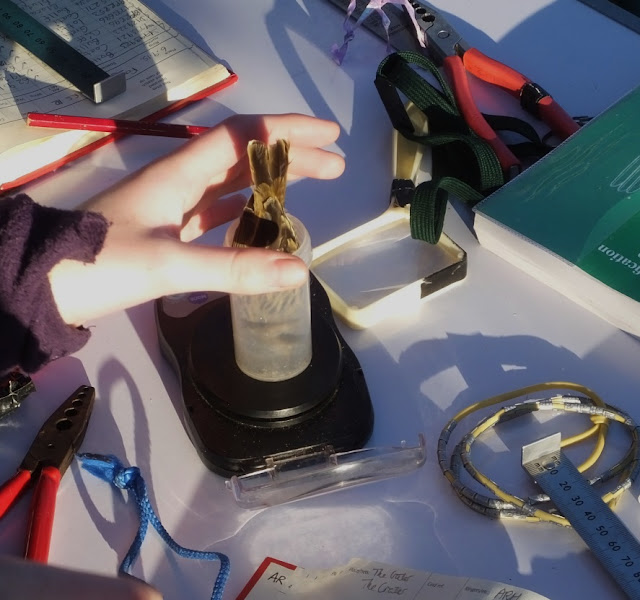The Safari left Base Camp before 04.00 on Sunday morning and headed north west over the border to Yorkshire.
About half way we nearly put an end to a Barn Owl which was hunting happily along the roadside verge until we were very close and it decided to try the verge on the other side of the road - silly bird! Also in the road, almost at journey's end were a Field Mouse and a Short Tailed Field Vole - although superficially similar they move very very differently out in the open.
The reason for our early morning exit was to meet up with young Alicia and see how she's been getting on with her ringing training. The meeting point was the middle of nowhere on the high moors in central Yorkshire. We got there just before sunrise.
We were eating a breakfast of egg and bacon butties when half of the Brisitsh Army turned up. They'd been roused early to go on manoeuvers and hadn't had their brekkie so looked on rather jealously - good job their guns were deactivated!
The nets were set and we retired to the ringing station (the cars) and waited for the birds to arrive.
 |
| Checking the nets |
 |
| There's one |
 |
| It looks worse than it is and the birds aren't harmed |
 |
| The ring needs to be checked to make sure it is tight but not too tight |
 |
| Wing length was measured along the longest primary feather |
 |
| The weighing procedure is rather ignominious for the poor birds - most weighed about 17 - 18g, the heaviest a tad over 20g |
 |
| The greater coverts are inspected to find out how many are old and how many have been replaced. |
Once all the details have been taken the results are written in the notebook before the bird is given to the trainer for checking before it is released, hopefully to be found by another ringer or a member of the public and reported back to the BTO.
After checking the notes are transcribed onto the final data sheet.
Although Meadow Pipits were the main target of the session other birds were around with a couple each of Goldfinches and Reed Buntings finding the net.
The trainer also explain to us how to determine how much fat the birds were carrying for their long journeys and how to score it.
By now it was mid-morning and the catch rate died off and it was time to pack up.
In the distance Hen Harrier free grouse-moors were clad with colourful Heather. Thee are Black Grouse up there too but they've had a poor season with one gamekeeper up there catching no fewer than 81 Stoats in a short space of time, possibly the cause - or partial cause - of the failure to produce any young this season.
Also up there on 'our' grassy moor were some Skylarks, a Kestrel, a Sparrowhawks and a kettle of six Buzzards enjoying the breeze coming up over the brow of the hill, and about 200 Goldfinches feeding on the thistle seeds. 51 Pink Footed Geese came from the north then turned towards the east coast.
Invertebrates came out with the warm sunshine and we had a nice selection of butterflies, Small Tortoiseshells, a Peacocks and a couple of Red Admiral. A Larch Ladybird on the ringing table was a bit of a surprise but less so were some Black Darters whizzing around the pools.
A number of Fox Moth caterpillars were pointed out to us.We managed to upset one and it rolled into a defensive ball.
Also nearby was a smaller caterpillar we think might be a Ruby Tiger.
Once all the ringing gear was packed into the vehicles, for the very last time as it was explained to us that Meadow Pipit migration up here was just about over now with catches dropping from 300 a day last weekend to just 55 today, we were taken to Alicia's local nature reserve, Foxglove Covert, where we met up with her mum and sister and lovely dog Poppy for a picnic lunch and a walk around the trails.
The reserve isn't that big but it has a multitude of habitats, almost all you can think of except a coastline, desert, tropical rain forest and an ice cap!
Being mid-afternoon there wasn't much bird life around but a family of Little Grebes on the lake kept us entertained for several minutes guessing where they'd pop up next. In one of the hides another Larch Ladybird was found.
What a place, it can apparently be tricky to get in as it's right in the middle of an army barracks but we had no trouble at all. It's well worth a visit!
Autumn colours were just beginning to show too.
We met one of the volunteers who was throwing some cut apples in to the ponds for the Water Voles while Alicia's dad kept himself occupied trying to get pics of Emperor dragonflies in flight. The volunteer told us that on Monday there was a training course about Mud Snails of which there is a good population on the reserve and at least one quite rare species. Reading the blog bout it today we discovered the training course was delivered by the same person as surveyed all our ponds on the North Blackpool Pond Trail - it's a small world!
All to soon our time in Yorkshire ran out and it was time to point the car back down the hill to Lancashire...we'll be back; it really was a superb place and well worth another visit to explore it in more depth with our friends.
Where to next? More Patch 2 stuff coming up.
In the meantime let us know who's habitatilicious in your outback.


















No comments:
Post a Comment